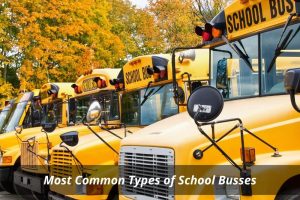Most Common Types of School Buses

What kind of bus does your child go to school on? Is it a yellow or green school bus? How about a double-decker bus? Or maybe a fire truck? If you don’t know, then you probably haven’t thought much about the type of school buses your children ride on. In this blog, we were going to discuss the most common types of school buses.
School buses come in various shapes and sizes. They vary from single-deckers to double-decker models. Some even feature special features such as flashing lights, sirens, and horns.
School buses are usually yellow or red in colour. The colours are chosen because they are easily visible at night and during bad weather conditions. The design of school buses also varies depending on their purpose. For example, some buses are designed to transport students and teachers, while others are equipped with ramps for wheelchairs.
The first school buses were used for transporting elementary and junior high school students. These buses had very basic layouts that included two rows of benches running along both sides of the vehicle. However, today’s school buses range from simple designs to elaborate ones.
Four categories Of Schools Bus
School buses can be separated into four categories: standard, mini, intermediate, and premium. Standard and mini-school buses have seating capacities ranging from 15 to 45 people each. Intermediate and premium school buses have seating capacities that are higher than those of the other types.
Standard school buses are ideal for carrying small groups of students. These buses often include a few tables so that passengers can eat lunch inside the vehicles. In addition, there is adequate space for storing books and supplies.
Mini-school buses are better suited for transporting large numbers of young children. Although these buses lack extra storage, they do have larger windows and air conditioning units. Many of them have an extra set of stairs for wheelchair users to use when boarding the buses.
Intermediate school buses include a combination of traditional school buses and coaches. This means that they carry fewer passengers but still offer amenities such as a cafeteria, restrooms, and a driver who speaks English.
Premium school buses are typically long and narrow. These buses tend to be taller and wider than traditional custodian buses. They often contain more legroom for passengers seated close together. Premium school buses are most often found in urban settings where space is limited.
Many different school buses are available, including motorcoaches; minibuses; school buses with ramps; and vans that function as school buses. All of these buses are well-equipped to serve the needs of students and parents alike.
Different Types Of School Busses
Motorcoach
A motorcoach is considered a common form of school transportation. It is equipped with all of the necessary amenities for transporting students and teachers safely. Motorcoaches are equipped with ample space for everyone onboard. They can accommodate anywhere between 20 and 50 passengers.
Minibus
A minibus is similar to a school bus in terms of its size and layout. However, unlike the latter one, a minibus is smaller in scale. Minibuses are designed for transporting a maximum number of students at once. They are best suited for schools that cater to kindergarten through grade 12 classes.
School Bus With Ramp
School buses with ramps are specifically made for transporting students with disabilities and mobility problems. These buses allow wheelchair users access to the vehicle even if it does not have a ramp built on it. The ramps come in varying heights, allowing for easy entry and exit.
Van
Vans are another type of school bus. They resemble conventional school buses in appearance, but they usually have a longer wheelbase. Vans are best suited for transporting a single class or group of students. They are also great for transporting large numbers of children simultaneously.
Transportation Assistance Services
School transportation has been around since the beginning of time. Parents rely on school buses to get their kids travelling to and from school. There are multiple methods by which you can arrange for a school bus to pick up your child. You may choose to sign up online, call a phone hotline or request a ride via text message.
School Bus Seats
The best way to ensure that your child arrives safely to and from school every day is to make sure he or she sits in a comfortable seat. School bus seating options vary according to the model. Some types of buses have rows upon rows of seats while others have just two or three benches along the back wall. Regardless of how many seats there are, each row should be separated by enough distance so that no one will fall into the aisle.
Each seat aboard a school bus must be secured with a safety harness. Children under 5 years old need to wear a restraining seat belt. Those five years and older must sit facing forward and secure themselves with belts. Adults are required to wear lap belts.
If your school bus has an air conditioning system, it would be great if the individual seats were kept cool during hot weather. This can be achieved by keeping them closed when the AC is turned off.
In what ways are school buses different from ordinary vehicles?
School buses differ from other modes of public transportation in several ways. They are larger in size than most automobiles. Most models do not have a trunk like regular cars. Instead, they have a storage area located behind the driver’s compartment. This allows the bus driver to store items such as books, sports equipment and lunch boxes.
School buses come in various colours. Many of them feature bright colours that attract attention. They also have distinctive designs that distinguish them from other vehicles.
School buses are safer than private vehicles because they are more regulated. Drivers of these buses undergo rigorous training before being allowed to drive this mode of public transportation. In addition to the standard requirements, school buses also undergo special testing procedures that involve driving down long roads at high speeds.
Buses are equipped with better brakes than most private vehicles. Their brakes are designed to provide maximum stopping power without causing damage to the wheels. They are also fitted with emergency braking systems that help drivers avoid accidents.
A school bus is designed to withstand harsh road conditions. It is equipped with stronger suspension systems that absorb bumps and potholes. All parts of the bus are well-maintained. Regular inspections take place to check whether any components are damaged.
What are the advantages of riding a school bus over other forms of public transit?
There are numerous reasons why people prefer boarding a school bus instead of taking public transportation. First, school buses are more reliable than private vehicles. They often run on fixed routes, which makes for predictable trips. Unlike buses that travel between random destinations, school buses always arrive at their designated stops within a specified time frame.
Bus schedules are available online and printed out. This helps parents track the location of their children throughout the day. Parents can even access information about the route taken by each student. This includes details about where the bus stopped and who was present.
School buses offer better amenities and security. They are spacious and safe. The interior of a school bus is usually divided into four sections: the driver’s cabin; the passenger section; the cargo space; and the engine room. Each compartment offers its own unique features.
School buses are cleaner than ordinary vehicles. They are less likely to emit harmful fumes and particulate matter. They also emit fewer pollutants during the combustion process.
School buses are quieter than other similar modes of public transportation. This is due to the fact that there is little or no traffic noise outside the vehicle.
School buses are equipped with better lighting. Because they operate at night, they are less likely to be involved in accidents. Moreover, they use brighter lights that allow passengers to see clearly while inside the bus.
What are the benefits of School buses?
School buses play an essential role in our everyday lives. Some of the benefits include:
• Safety – As mentioned earlier, school buses are safer than ordinary cars. This is because they are more regulated and undergo different types of tests. These tests require school buses to complete specific tasks under controlled situations.
• Comfort – School buses are typically equipped with comfortable seating system arrangements. Most of them have several rows of seats. There may be bench seats in some cases. Bus interiors are usually clean and well-lit.
• Convenience – School buses make transporting students easier and more convenient. Children can easily get to school using this type of public transport.
• Savings – Riding school buses saves money. Since they are generally cheaper than regular taxis, it is possible to save a lot of money if you ride one regularly. On top of this, you don’t need to pay parking fees anymore.
• Time – School buses tend to arrive at scheduled times. This means that you will not waste time waiting around for other cars to move away before you board a bus.
• Flexibility – School buses are highly flexible. You can choose when to leave home. If you work late, you can still go to school without worrying about missing classes.
• Privacy – Although they are larger than most private vehicles, school buses still provide adequate privacy. In many cases, school buses do not have windows. Therefore, they are unlikely to attract unwanted attention.





